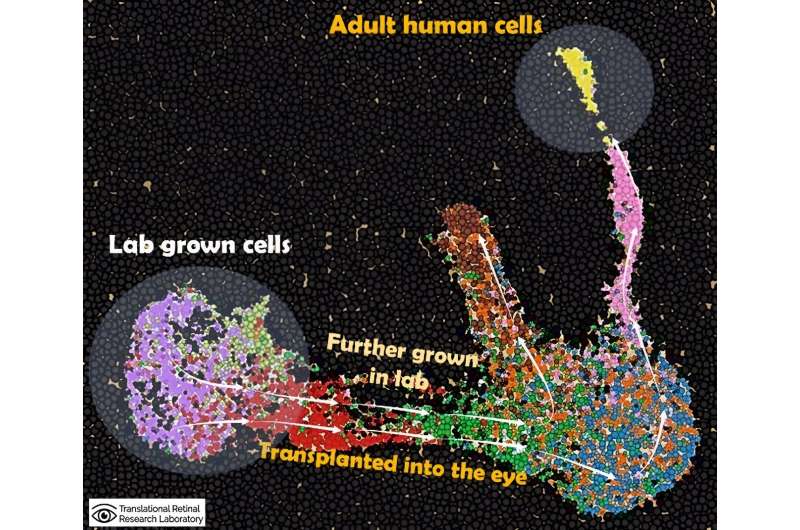This article has been reviewed according to Science X's editorial process and policies. Editors have highlighted the following attributes while ensuring the content's credibility:
fact-checked
peer-reviewed publication
trusted source
proofread
Advancing retinal cell therapy: New insights into transplanted retinal cells could treat degenerative vision in elderly

A team of scientists in Singapore has discovered new behavior in transplanted stem cell derived retinal pigment epithelial (RPE) cells, which could help treat Age-related Macular Degeneration (AMD), one of the leading causes of irreversible blindness and visual impairment in elderly. Using preclinical models, the research team identified a special group of transplanted RPE cells that closely resembled healthy adult human RPE cells, which play a vital role in supporting vision.
The team consisted of researchers from A*STAR's Institute of Molecular and Cell Biology (IMCB), Yong Loo Lin School of Medicine, National University of Singapore (NUS Medicine), Singapore Eye Research Institute (SERI) and Lee Kong Chian School of Medicine (LKCMedicine) under Nanyang Technological University (NTU) Singapore.
Led by Dr. Bhav Parikh, Scientist at A*STAR's IMCB and Dr. Paul Blakeley, Senior Research Fellow at NUS Medicine, the research team used single-cell RNA sequencing technology to understand the genetic behavior of individual cells in preclinical models, including its survival and maturation.
The findings highlighted that stem cell derived RPE cells evolve post-transplantation, and a subpopulation evolved to become closely similar to mature human RPE cells. This subpopulation expressed genes that support vision and promote cell survival. This indicates that studying the transplanted retinal cells at the single-cell resolution is critical for uncovering specific cellular changes which impacts the outcome and effectiveness of retinal cell therapy.
The insights could help researchers improve the survivability, functionality, and host integrability of transplanted retinal cells, as well as develop therapeutics for eye conditions in the future.
It is projected that AMD will affect 288 million people in 2040. While there are ongoing clinical trials for retina cell therapy which have proven to be safe, there has not been an approved cell therapy product for AMD. This may be attributed to the lack of robust methods to evaluate the efficacy of the transplanted RPE cells, including cell survival, and integration within the human eye to support vision recovery.
This study provides new insight into the biology and functions of transplanted RPE cells, which could help advance the understanding of cell-based therapy treatment for AMD, and other eye conditions in the future.
"Advancing AMD treatments via cell therapy hinges on uncovering the key elements that bolster the endurance, integration, and functionality of stem cell derived RPE cells after transplantation into the eye. Using single-cell RNA-sequencing, we discovered the precise factors that empower RPE cells to not only survive but also integrate and perform optimally in supporting vision," said Dr. Parikh, lead author of the study and Scientist at A*STAR's IMCB.
"This work has future implications to enhance outcomes of RPE cell therapy. For example, prior to transplantation, RPE cells in culture that display this distinct gene expression profile can be selectively chosen for RPE transplant to enhance post-transplant survival. Moving forward, we hope to develop manufacturing processes in line with cGMP regulations to culture these 'superior' RPE cells for AMD treatment," said Dr. Su Xinyi, corresponding author of the study, Acting Executive Director at A*STAR's IMCB and Assistant Professor at NUS Medicine.
"Current therapies in AMD based on pharmacological agents have limited effect in cases of advanced visual loss. Cell-based therapy may address this important unmet need. This work is important in advancing cell-based therapy in AMD," said Professor Gemmy Cheung, Head, Medical Retina Dept, Singapore National Eye Centre (SNEC) and Head, Retina Research Group, SERI.
The paper is published in the journal Proceedings of the National Academy of Sciences.
More information: Bhav Harshad Parikh et al, Single-cell transcriptomics reveals maturation of transplanted stem cell–derived retinal pigment epithelial cells toward native state, Proceedings of the National Academy of Sciences (2023). DOI: 10.1073/pnas.2214842120





















